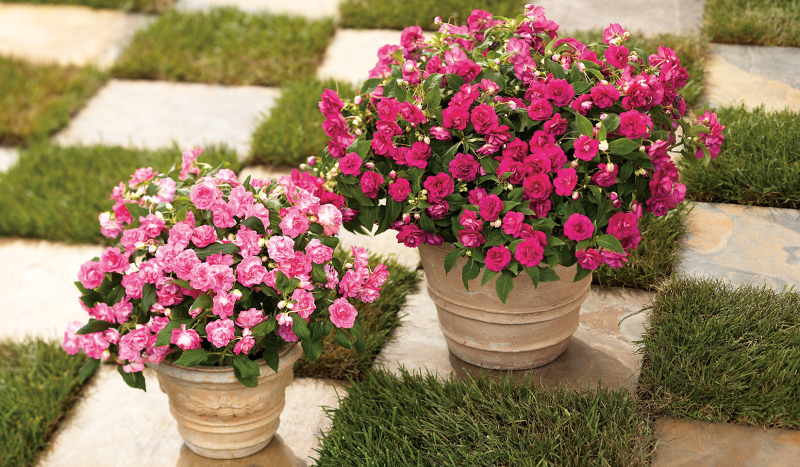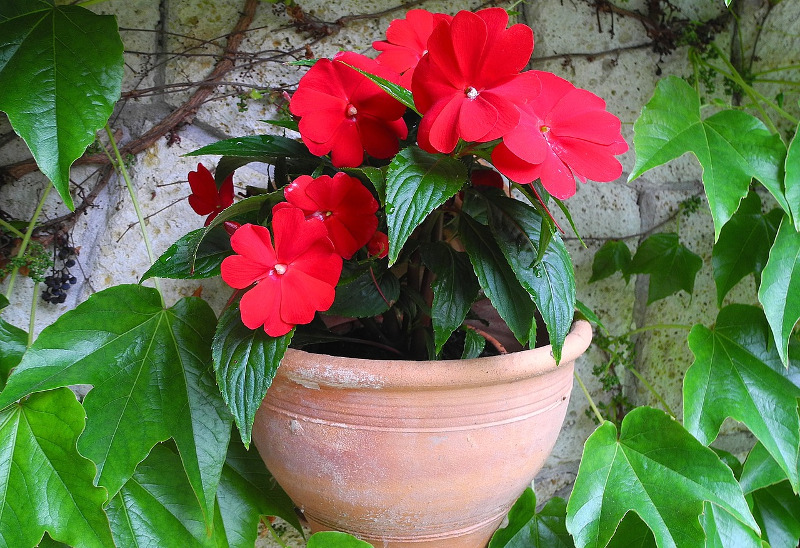Impatiens are tropical plants grown for their vibrant blooms that easily brighten up a shady patio or a shadowy corner of a yard. This shade-loving plant is versatile, and it can thrive in the ground, planters, or hanging baskets. Use Impatiens as the only plant in a container to make a bold statement, or use Impatiens as a filler and spiller to add a pop of color to a group planting. Impatiens will flourish and look stunning in a container as long as the conditions are right.

Planting Impatiens in Pots
Impatiens grow as annuals in most areas, and these tropical plants cannot handle cold temperatures, so wait to plant until there is no longer a threat of frost. Place the planter in an area with part shade. Impatiens do best with 2 to 4 hours of filtered light during the morning and afternoon shade.
Impatiens can maintain a compact growth habit or spread out depending on the variety, and generally, a 12-inch container can support 3 to 4 plants. We suggest using a container with drainage holes to drain excess water out of the pot. Impatiens like damp soil, but constant exposure to standing water will cause root rot. Plastic, metal, or other non-porous container materials are best for Impatiens because they retain moisture, so the plant will not need water as often. Potted plants need water more frequently than plants in the ground, but plants grown in terracotta or unglazed ceramic will possibly need water daily.

Best Soil For Impatiens in Pots
Use rich, slightly acidic, well-draining soil for Impatiens. Amend the soil with compost to provide extra mineral and vitamin content to help the plant thrive. Place mulch on top of the soil to help hold in moisture.
Caring For Impatiens in Planters
Impatiens are lovely container plants that can brighten up a porch or deck when placed on steps or a tabletop. Varieties with a larger spread do very well in hanging baskets that display long stems and striking flowers. Impatiens need part shade and damp soil to thrive, so potted Impatiens should be placed in an area with filtered light. We suggest using a container with drainage and rich, well-draining soil.
Watering Impatiens in Pots
Plan to water potted Impatiens at least every few days. Soil dries out more quickly in containers, so expect to water the plants more often. Container-grown Impatiens may need water daily during a heatwave. Monitor the weather and feel the soil to ensure the plant needs a drink before giving it water.
Fertilizing Impatiens in Pots
Plants grown in pots need water more often, and this causes the nutrients in the soil to be rinsed away more quickly. Feeding the plant regularly will replenish the soil and keep the plant healthy. We suggest feeding potted Impatiens using a water-soluble fertilizer. Fertilize Impatiens every other week and incorporate the feeding into your watering routine.

Winter Care For Impatiens in Pots
Impatiens grow as annuals in most areas, and the plants will die back when the weather turns chilly. Potted Impatiens can be brought inside to overwinter in areas that experience cold winter weather.
Impatiens grow as perennials in USDA zones 10 and 11. In those zones, continue to care for the plant throughout the winter. Impatiens may need less water if they are not actively growing, so monitor the soil and only water if the top layer of the soil feels slightly damp. Cover the plant if the weather forecast calls for cold overnight temperatures.
Growing Impatiens Indoors
Impatiens can be grown as houseplants, making it possible to protect the delicate plants from winter conditions. Cut back the stems to about 3 inches in length and bring the potted plant indoors. Place the Impatiens in a South-facing window and water when the top layer of the soil is just slightly moist. Impatiens do not need to go dormant, but the plant may take a break from growing if there is not enough light.
Plants We Recommend
 |
Author Alison Cotsonas - Published 10-01-2022 |
